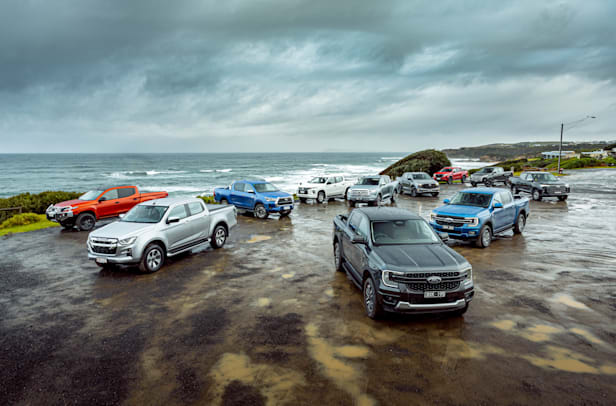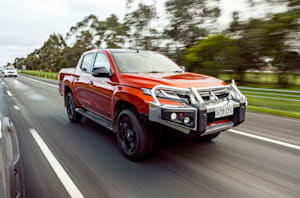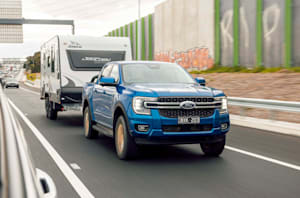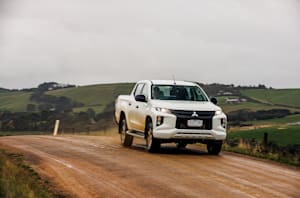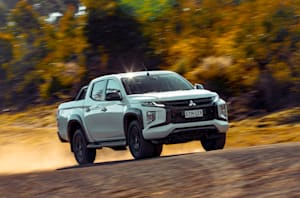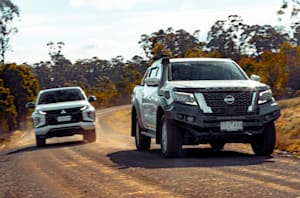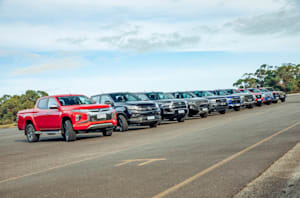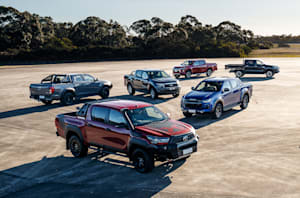The Japanese-bred Mitsubishi Triton ute is available in single-cab, club-cab, and double-cab configurations, in either cab-chassis or pick-up guise.
A vast 4x4 and 4x2 model line-up consists of the entry-level GLX, GLX+, GLX-R, GLS and the top-spec GSR. Premium models are equipped with a Super Select II full-time 4x4 system, while lower-spec variants get a more rudimentary Easy Select part-time 4WD system.
All models – except a petrol-powered GLX cab-chassis – are powered by a 133kW/430Nm 2.4-litre MIVEC turbo-diesel engine that runs through either a six-speed auto or six-speed manual transmission.
The Mitsubishi Triton range received an upgrade in 2020 that introduced revised front-end styling, terrain-specific driving modes, and a suite of advanced safety tech.
A new Triton is set to launch in 2023, with a plug-in hybrid powertrain expected.
In a heavily populated ute segment, rivals for the Triton include renowned models such as the Ford Ranger, Nissan Navara, and Toyota HiLux, while more budget-oriented offerings include the likes of the GWM Ute, LDV T60, and SsangYong Musso.
Latest Review
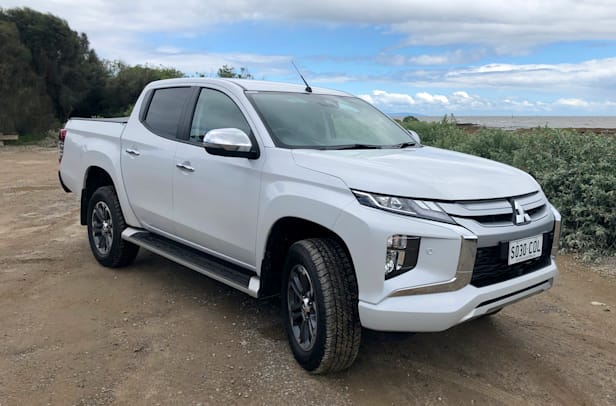
2022 Mitsubishi Triton GLS review: The dad weekender drive
When the opportunity arose for one of our resident SUV owners to drive Mitsubishi's dual-cab ute for a week, how did the Triton compare?
To be honest, I feel much more at home leading Wheels Media’s technology team than I do sharing my impressions of a dual-cab Mitsubishi Triton ute, but I jumped at the opportunity when the keys came my way.
My own daily drive is a 2022 Kia Sportage GT-Line, which more than comfortably navigates the occasional school run and myriad weekend activities that accompany being the father of a twelve-year-old daughter.
However, I’d be lying if I said the thought of purchasing a ute hadn’t crossed my mind before the Sportage rolled into our driveway.
Aside from a fortnightly trip to Bunnings and a penchant for a fishing trip, I can’t say we’ve had a real need for a ute, but when it seems like every second family around you has one, you start to wonder what they’re like as a family car. So with that in mind, I was keen to get behind the wheel and find out.
JUMP AHEAD
The Car
2022 Mitsubishi Triton GLS: From $51,940 before on-road costs
First Impressions
The Mitsubishi Triton GLS struck me as fairly appealing to look at as I peeked at it through the office kitchen window.
Sitting just one notch down in the range from the top-spec GSR, it carries some nice styling that the cheaper variants miss out on.
Getting in, the one-touch start system kicked things off and as the diesel engine rumbled into life, I had a feeling that this was going to be a fun little experience. Call it petty, but there’s a masculine feeling tied to jumping in a dual-cab and hearing that diesel engine chugging away.
Inside the cabin, despite some slightly older tech, the ute came across as a nice modern package and I was looking forward to becoming acquainted with it.
Once I got myself settled in and adjusted the mirrors, the size of them immediately caught my attention. They weren’t huge, but they were big enough to immediately give the feeling that I had the peripheral vision of Michael Jordan.
After anticipating that the Triton would feel so much bigger to drive than the SUV I’m used to, the ease of seeing my surroundings meant any size concerns immediately dissipated.
Comfort
The Triton has a decent interior – a solid finish that’s easy on the eye without trying too hard to be fancy.
It’s polished just enough to look good but seems tough enough to hold up for everyday wear and tear and if I were on the tools every day, I’d feel comfortable jumping in and out and not stressing too much about damaging surfaces.
I found the front seats took some getting used to with what felt like quite a snug fit. With each day, I came to really like them and what initially felt like a bit of an uncomfortable hug soon felt really supportive.
The seat warmers provided a nice little touch of comfort as well, and with high and low settings, did exactly what you’d want them to do.
Also, the Triton's comfortable rear seats provide loads of space if you have kids in the back. Even for me, not exactly small at 188cm, sitting in the rear seats provided a little bit of headroom and enough legroom so long as the front seats weren’t set too far back.
I’d feel fine about loading up the Triton with a few mates on the way to the footy without feeling like we’re packed into a can of sardines.
Technology
The large infotainment displays in my Sportage have left me a little spoiled when it comes to in-car tech, so I tried to taper my expectations before evaluating the Triton’s set-up.
Although the infotainment display in the Triton seemed relatively small at first, it does the job. The native interface is simple to use and easy to connect a smartphone via Bluetooth. Like the Sportage, Apple CarPlay (and Android Auto) requires connection via USB as, unfortunately, there’s no wireless support.
That’s perhaps not a huge issue but it does become tiresome if you’re in and out of the car throughout the day and creates a bit of an eyesore with a USB cable curling around on what is otherwise a tidy console.
In total, the centre console provided two USB-A ports and one HDMI port, while another two USB-A ports were available at the rear to keep any passengers fully charged and happy.
On the road
After being more accustomed to SUVs and sedans, jumping up into the cab of the Triton felt quite different, although that feeling quickly subsided as I navigated home from Wheels Media HQ for the first time.
The Triton took noticeably more effort than an SUV to get around 90-degree turns but that soon felt normal. It was actually quite fun while I was still getting used to the handling and turning circle but before I knew it, it felt like I’d been driving this ute for weeks.
Slotting the Triton into daily life, things were kept relatively normal around the family routine so we didn’t head off-road or give it a thrashing but for the everyday urban driving I was doing, it felt more than sufficient.
Whenever quick acceleration was needed in traffic, to slot into that gap in the next lane or power up an incline, the Triton responded confidently and soon enough, I could see myself enjoying it as a daily driver.
It’s certainly no performance car with a 133kW/430Nm 2.4-litre turbo-diesel engine having to shift 1991kg of vehicle, along with whoever and whatever it's carrying, but it has enough grunt to get through the day and get the job done in comfort.
The braking performance was impressive and the Triton didn’t hesitate to pull up quickly for the occasional red light – far better than I thought it would. I can’t comment on how it would perform with a full load in the back but would expect it to be similarly stable.
Driving along smooth roads was a slick experience but throw in some little bumps or potholes and you could feel the ruggedness of the Triton kicking in. As the driver, I saw these bumps approaching so knew what was coming, but for my wife and daughter as passengers, the slightly bumpy ride on relatively normal roads was sometimes a noticeable discomfort.
I imagine you’d soon become accustomed to the ride, but it’s one noticeable trade-off versus the smooth ride of an SUV.
Having said that, the Triton had no issues handling dirt roads and from what I found, was as a capable performer as you might rightly expect.
On the topic of rough roads, I’ve often wondered where the jack is kept in a dual-cab ute; in the Triton, I found it tucked away behind the rear seats, which tilt forward easily with the pull of a lever.
Lastly on the drive, one of the most impressive aspects of the Triton was how much visibility you have while driving it. As I mentioned earlier, the large side mirrors ensured I had a comprehensive view of what was going on around me – not something I expected before taking the keys.
Safety
Safety-wise, the audible alerts aren’t fancy but certainly get your attention when they need to.
To begin with, if you haven’t put your belt on before starting the engine, you get a symphony of dinging until you do.
The amber blind-spot monitoring lights on the mirrors work well and provide awareness of vehicles you might otherwise not know are there. Combined with the broad view provided by the mirrors, you rarely feel out of touch with what’s around you.
Annoyingly, the forward collision warning is sometimes triggered when navigating tight streets with cars parked on either side of the road. Perhaps that’s being a little picky, given they’re just doing what they are supposed to, but combined with the audible alarm, they just seem a little over-zealous.
Parking
The length of the Triton was the first noticeable difference when I first had to park it.
Compared to my SUV, the length of the Triton required a little more care to navigate into tight spaces and, admittedly, took a few goes to begin with.
Having said that, it was surprisingly easier to reverse the Triton into a parking space than it was to go in forwards. The size of the bonnet made life a little more difficult than it needed to be when parking nose first, while in contrast, the high rear end of the ute made reverse parking easier when overhanging a kerb.
Overall, the mirrors provided a great field of view, the sensors were accurate and the reverse camera worked well enough to provide a confident parking experience even when unfamiliar with the vehicle.
Last impressions
Having very lightly toyed in my mind with the thought of purchasing a dual-cab ute in the past, versus an SUV, I can absolutely see the appeal now.
Our little family was a bit sad to see this one go, so we’ll be looking on fondly when we see one passing by on the road.
Besides the lack of wireless Apple CarPlay, there wasn’t much that annoyed me during the week behind the wheel of the Triton and I was truly surprised at how quickly I felt at home behind the wheel.
The Mitsubishi Triton GLS is a nice package at an attractive price point versus the competition. If I regularly needed the carry space of the tray and wanted something I could get dirty inside and out without stressing over it, I’d seriously consider one.
2022 Mitsubishi Triton GLS specifications
| Version | 2.4 DiD GLS Double Cab Ute 4x4 Auto |
|---|---|
| Price | $51,940 |
| Transmission | 6 SP Automatic |
| Drivetrain | 4x4 |
| Power (kW) | 133kW |
| Fuel Type | Diesel |
| Fuel (city) L/100km | 8.6L/100km |
| Seats | 5 |
| Doors | 4 |
| Wheelbase (mm) | 3,000mm |
| Overall Width (mm) | 1,815mm |
| Overall Length (mm) | 5,305mm |
| Groundclearancemm | 220 |
| Weight (kg) | 2,000kg |
| Country of Assembly | Thailand |
Things we like
- Mirrors and sensors provide surprisingly good awareness of surroundings
- Clean styling, inside and out
- Rugged, yet nicely finished interior
Not so much
- Lack of wireless Apple CarPlay/Android Auto
- Over-zealous forward collision warning
- Not always the smoothest ride
News
-
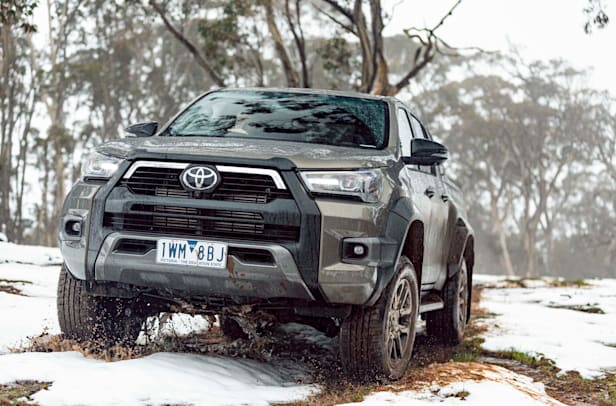 News
NewsVFACTS November 2022: HiLux back on top as SUVs outsell LCVs
Sales climb again in November with most brands experiencing growth, and SUVs proving particularly popular
-
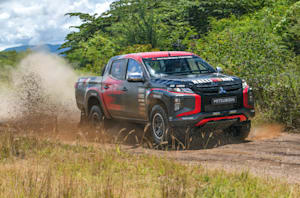 News
NewsMitsubishi Triton Ralliart race team wins 2022 Asia Cross Country Rally
Mitsubishi’s famous rally division has returned to victory in Asia
-
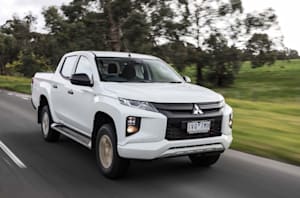 News
NewsMitsubishi wants an electrified Triton, but cost concerns mean we’ll need to wait
An all-electric Triton isn’t on the cards, and there’s still work to be done on a hybridised Mitsu utility
-
 Advice
AdviceDual-cab ute safety features explained
How do Australia's most popular utes compare when it comes to safety? We put it to the test
-
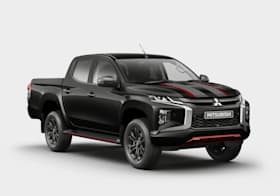
2023 Mitsubishi Triton: pricing, features and new special edition
-
VFACTS September 2022: Supply boost gives car brands bumper month – with Tesla Model Y nabbing a top 10 spot
-
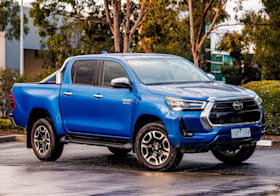
VFACTS August 2022: Brighter skies emerge for new car sales
-

Mitsubishi planning Ralliart return, Triton likely first up


